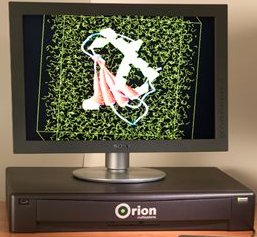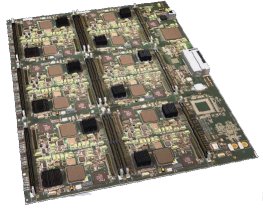Linux powers 96-node “personal cluster”
Apr 26, 2005 — by Henry Kingman — from the LinuxDevices Archive — views [Updated 1:00PM PDT] — Orion Multisystems is shipping a Linux-based “personal cluster” based on 96 Transmeta processors in a case little larger than a normal PC. The DS-96 Deskside Cluster Workstation costs $100,000, draws 1,500 watts, and offers 110 Gflops sustained and 230 Gflops peak performance, Orion claims.
[Updated 1:00PM PDT] — Orion Multisystems is shipping a Linux-based “personal cluster” based on 96 Transmeta processors in a case little larger than a normal PC. The DS-96 Deskside Cluster Workstation costs $100,000, draws 1,500 watts, and offers 110 Gflops sustained and 230 Gflops peak performance, Orion claims.
 Previously, Orion offered a 12-node personal cluster, the DS-12, pictured at right.
Previously, Orion offered a 12-node personal cluster, the DS-12, pictured at right.
Both the DS-12 and the new DS-96 target supercomputing applications in science, engineering, entertainment, finance, and government. They are intended to free individual researchers from the onus of scheduling computing time in shared cluster facilities.
Orion says the Linux operating system enables its Deskside Cluster systems to run a variety of popular open source scientific applications. The company's website offers FAQs about applications that include Amber, GAMESS, GROMACS, HMMER, iNquiry, gridMathematica, MatLab, mpiBLAST, NAMD, and NCBI BLAST.
 The DS-96 is based on eight vertically oriented boards (shown at right), each with 12 Transmeta Efficeon processors running at 1.2GHz. The boards are connected through a Gigabit Ethernet switch fabric backplane. The backplane offers various uplink options, such as a dual 10-GigE fiber card or 12-port GigE switch cards. Up to four DS-96's can be combined into a single cluster, Orion says.
The DS-96 is based on eight vertically oriented boards (shown at right), each with 12 Transmeta Efficeon processors running at 1.2GHz. The boards are connected through a Gigabit Ethernet switch fabric backplane. The backplane offers various uplink options, such as a dual 10-GigE fiber card or 12-port GigE switch cards. Up to four DS-96's can be combined into a single cluster, Orion says.
Each processor node includes a DIMM slot, for a total claimed memory capacity of 192GB. Each board has room for a 2.5-inch laptop drive, for a claimed storage capacity of 9.6 Tb.
The DS-96 also includes a head node with a DVD/CD-RW, USB port, Gigabit Ethernet port, a single 2.5-inch hard drive, and an ATI Mobility Radeon 9000 with 64MB of integrated DDR video RAM.
The DS-96 measures 17 x 27 x 25 inches, and weighs 150 pounds. It draws a claimed peak of 1,500 Watts through a single 15-amp NEMA (normal) wall outlet.
Jim Lux, an engineer at NASA's Jet Propulsion Lab, said, “The new 96-node deskside system provides an order of magnitude higher performance than the desktop, still without requiring extensive support staff and infrastructure.”
Rob Edwards, an adjunct assistant professor at San Diego State University, said, “We don't have a significant IT staff to manage a large cluster, and Orion provides systems we can conveniently operate and maintain ourselves.”
Stacey Quandt, open source practice analyst at Robert Francis Group, said, “Just as high-performance clusters of smaller servers have joined monolithic mainframes, server clusters are beginning to gain client-side analogues. Such systems, if configured and deployed effectively, can deliver new computing options and enable more and new business benefits at many enterprises.”
Orion Multisystems was founded by Colin Hunter and Ed Kelly in 2003. Hunter and Kelly also co-founded Transmeta, which earlier this year said it might stop making chips. However, Transmeta announced at the end of last month that it has committed stock to key customers, including Orion, says Orion's Joshua Shane. “We have stock through this year very comfortably, and although we have not made any product roadmap announcements, we're engaged with other other x86 chip vendors, and have a good runway for the future,” Shane said.
The DS-96 is shipping now, with prices starting at $100,000. Orion Multisystems expects to announce a European distributor soon.
This article was originally published on LinuxDevices.com and has been donated to the open source community by QuinStreet Inc. Please visit LinuxToday.com for up-to-date news and articles about Linux and open source.